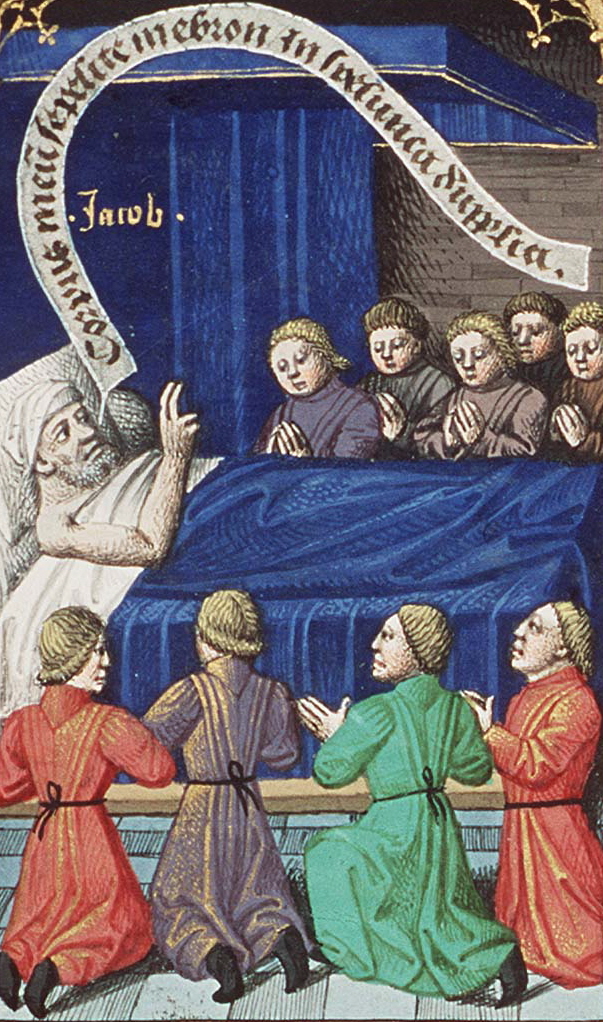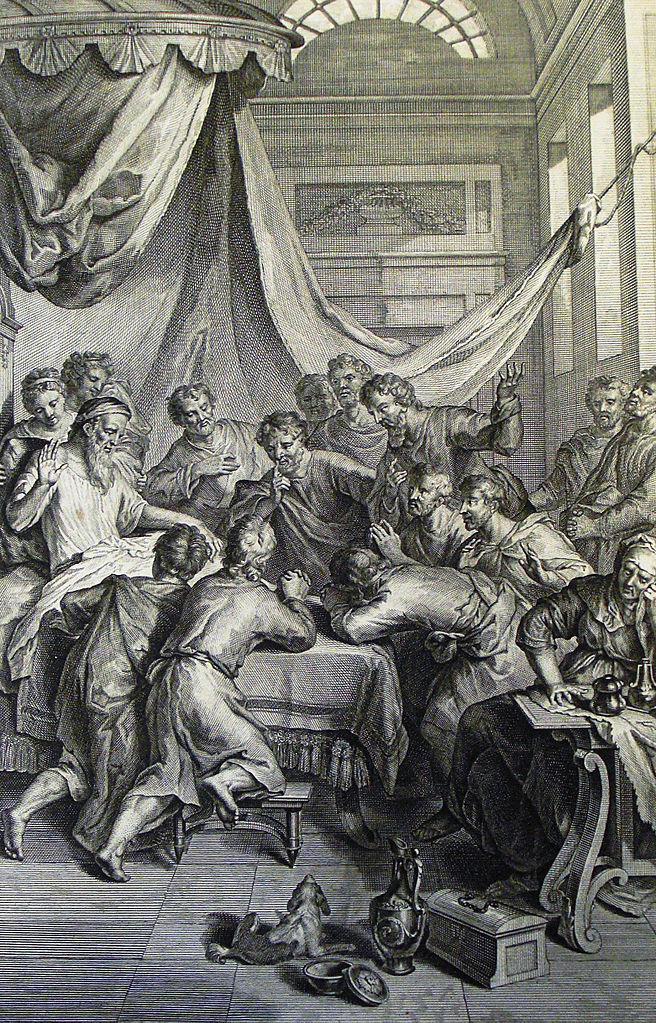Pictures at a Benediction: Envisioning Jacob’s Blessing of his Sons

The Tanakh is notoriously parsimonious when it comes to providing visual details. They are supplied only when they are germane to the biblical narrative. Was Isaac good-looking? We are not told. But we are told that Joseph was, because it explains why Potiphar’s wife cast her eyes upon him. Was Moses bald? We will never know. But it is made clear that the prophet Elisha was; because of this, he was taunted by jeers: “Go away, baldhead! Go away, baldhead!” This is the beginning of the brief but horrifying story in which Elisha curses the children who mock him, who are then mauled by bears emerging from the forest (2 Kings 2:23-24).
Along these lines, one may wonder: what did Jacob’s bedchamber look like when the brothers came to receive their final blessings—and curses? (Gen. 49) I have found numerous artistic renderings, but two in particular caught my attention because of how differently they paint the scene.

One is a miniature by the 15th century manuscript illuminator Francois le Barbier, also known as Maître Francois. He depicts the sons kneeling solemnly before Jacob. The sons are ranged on both sides of the bed, dressed in identical clothing. However, on one side there are four sons attired in a dark, monochrome fashion. There are also four sons on the other side; two dressed in red, one in green, and the fourth in a dull purple. As opposed to the monochrome sons, whose gazes are modestly directed downward, two of the more colorfully dressed sons look toward Jacob with glances of supplication; one of the others is looking towards one of his brothers. The face of the fourth is hidden. As for Jacob, he reclines with his right hand raised in the iconic Christian gesture of blessing—index and middle fingers (and presumably thumb as well, though it is obscured) raised. Words literally scroll forth from his mouth, containing the request that he be buried in the cave of Mahpelah in Hebron.
It is hard for me to infer the significance of the differences in clothing and expression. Are the sons in colorful attire Reuben, Simeon, Levi, and Judah? Is Joseph the brother dressed in purple? No matter who is who, the scene is presented as a decorous one. Though the glance of the brother looking at his sibling may be anxious, as a whole the sons seem ready to accept whatever words issue from Jacob’s mouth, good or bad.

Very different is the engraving by Gerard Hoet in the 1728 volume Figures de la Bible. Here we are in a riotous marketplace. Jacob’s space is invaded by a horde of competing petitioners. One son has his head down upon the bed, his forearms raised and hands clasped in supplication. Others look toward Jacob in entreaty. One seems to be reasoning—or arguing—with his father. Another stands far from Jacob, leaning—or rather sagging—against the wall; his facial expression and body posture bespeak defeat and despair. There are even some women in the background and a disgruntled nurse in the foreground, obviously annoyed at being hindered in her ministrations. And in the midst of it all is Jacob. He sits upright; his right hand is open and extended, a gesture that seems to be a plea for order and quiet.
The first depiction likely presents the scene as Jacob might have imagined it: “I will bless or curse each of my sons as is his due. Each will understand that my words are fitting and will accept them unquestioningly. I will then die in peace, be mourned by my sons, and be buried with my fathers.” The second depiction likely reflects more accurately how the sons would have experienced their last moments with their father. Some fear what will come; some await it eagerly. Some yearn for paternal compassion; some await blessing as their due. Some are hopeless and turn away despondent and angry. And all of them know that there are many others in the room, vying with each other for the limited attentions and affections of an old and dying man.
Those of us who are parents often think that we know our children and what is best for them. We see ourselves apportioning appropriate measures of praise and criticism to each of them—appropriate because we know them and what they need. And surely, we imagine, they all know that we love them equally and that there is no need for them to feel in competition with one another for our affections.
And then we remember that we, too, are children. Some of us may remember parental criticism that we felt was hurtful and undeserved. Some of us might recall how a father’s praise of one child can feel like an act of criticism or denigration for another. We may recollect that when great love and attention are showered upon one sibling, another may wonder how much love is left for her. And some of us might remember a sense of how much there is that our parents don’t know—or, perhaps, never did understand—about us.
Le Barbier’s depiction is an attractive but false one; Hoet’s is dispiriting but truer to life. The world of children and parents is not neat and ordered. Love and jealousy live side by side; insight and ignorance dwell together. Whatever blessings parents seek to give their children, let them be given with humility and sensitivity, both toward them and toward any siblings who are looking on—and they are always looking on.
The publication and distribution of the JTS Commentary are made possible by a generous grant from Rita Dee (z”l) and Harold Hassenfeld (z”l).



